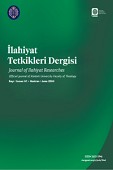Hallâc-ı Mansûr’un Düşünce Dünyasında Ene’lHak Şiirinin Arka Planı -Kitābü’ṭ-Ṭavāsīn ve Dīvānü’l-Ḥallāc Özelinde
The Background of the Poem “Ana al-Ḥaq” in al-Hallāj’s Thought with Particular Reference to Kitāb al-Ṭawāsīn and Dīwān al-Ḥallāj
Author(s): Kenan MermerSubject(s): Islam studies, Turkish Literature, Sociology of Literature
Published by: Atatürk Üniversitesi İlahiyat Fakültesi
Keywords: Turkish Islamic Literature; al-Hallāj; Kitāb al-Tawāsīn; Unity of Being; Nūr al-Muḥammadī (Muhammedan light); Ana al-Ḥaq(I am the Truth);
Summary/Abstract: The conceptual richness realized when categorizing existence and understanding the highest truth is remarkable. For example,whenthe findings of natural sciences and the principles of logic put forward by Aristotle three hundred years before Christ, or Plato’s fiction of the world of ideas, shadows and origins, which had an intense influence on Sufi imagination, or even the way his teacher Socrates established morality and considering the attitude that prioritizes conscientious justice when he faced the death penalty are taken into consideration,it will be noticed that it is difficult to talk about a linear progress in abstract thought and perception of ethics. When considered within the scope of Sufism, the theories of unity of Being and unity of vision have been developed long before the official narrative constructed between Ibn ‘Arabī and Imām Rabbānī. Hallāj’s saying that “He is He”, “I am what I love, I am He; And He is I. We are as if two spirits fused together in a single body." refer to both the ancient practices of understanding Being in a single essence and the values of figurative language in terms of being a medium to the truth. Although the idea of the Supreme Being or the Transcendental Being is seen in a clearly defined area of negation in al-Hallāj, some of his expressions in his Dīwān and Kitāb al-Ṭawāsīn may confuse the reader. At this point, the necessity of not ignoring the expressions/stylistic forms called language of birds/mantiq al-tayr, and theopathic statement (shathiya) emerges automatically. Understanding the person, the Sufi or the artist in question can only be possible by looking at the whole picture emerged through his life story and works. Starting from this point, the breaking points in al-Hallāj’s life, his masters and his travels allow us to understand the esoteric color and sakr(intoxication) centered vision of Being that marked his thought. Thus, an intellectual gateway can be opened to understand, at least partially, why someone who says I am the Truth (Ana al-Haq) says this and for what purpose.
Journal: İlahiyat Tetkikleri Dergisi
- Issue Year: 2024
- Issue No: 61
- Page Range: 11-25
- Page Count: 15
- Language: Turkish

